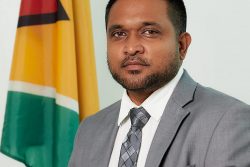Dear Editor,
I write in support of Shaundell Shipley’s letter in SN, December 16, 2020 entitled, `We need to challenge cultural norms when it comes to gender inequalities’ especially her call, not heard often enough, for the inclusion of boys and men “who suffer too, sometimes equally” from gender-based violence.
I agree with her recommendations which bear repeating: more public awareness; hand holding, safe houses, economic empowerment, counseling for victims; everyone being an activist against violence, forward thinking, and development of an emergency response action plan against gender-based violence.
Recently, Vidya Kissoon, an activist against violence, drew attention to the fact that all the gender-based violence training we have engaged in has not seemed to make a difference. In the spirit of ‘forward thinking,’ I therefore suggest that we shift the focus to power-based violence across the gender and age spectrum; and instead of ‘stricter penalties for perpetrators,’ I suggest we consider a more humanizing approach. Just as I was about to dispatch this letter, I saw the Childcare & Protection Agency report headed, “Parents are perpetrators in 85% of reported child abuse cases” (SN, December 19, 2020). Now that we have evidence identifying the main ‘perpetrators’ (and they are not even fathers), we can pause the knee-jerk reaction so many in our society exhibit towards ‘perpetrators,’ usually on the assumption that they are men doing violence to women.
I also want to note that in another newspaper, Ms. Shipley speaks of trauma-informed counseling. This is a crucial and important distinction, because counseling (therapy is closer to what is actually needed) that is not ‘trauma-informed’ is not sufficient for healing the deep wounds that violence leaves – on victim and perpetrator. Perpetrators of violence against others often are persons who have been victims, typically unacknowledged victims, of one or more of the multiple forms of trauma that characterize our society. “Hurt people, hurt people” is one of the truest of the violence-related slogans. If we make the time and effort to examine the formation of perpetrators, evidence of physical and/or emotional neglect and abuse is likely to emerge.
Posttraumatic stress disorder (PTSD) is now widely understood to be the reason why so many veterans of war harm themselves and harm others. But the Adverse Childhood Experiences (ACE) study data caused one key researcher to ‘stumble’ on the fact that ‘the gravest and most costly public health issue in the United States is child abuse … and that eradicating child abuse in America would reduce the overall rate of depression by more than half, alcoholism by two-thirds, and suicide, IV drug use, and domestic violence by three-quarters. It would also have a dramatic effect on workplace performance and vastly decrease the need for incarceration.” (See Bessel van der Kolk, The Body Keeps the Score: Brain, Mind, and Body in the Healing of Trauma.)
When I read our newspaper reports of perpetrator behaviours, whether of the mother who ‘confessed’ to beating and abandoning her unconscious six-year-old daughter in a swamp or the teacher sentenced to three years’ imprisonment for sexual abuse of his student or the police who attacked the traumatized brother (chained like a dog to the floor of the police station) and the traumatized mother of one of the two murdered Henry boys (SN, December 17. 2020), I think of our cultural norms which make it acceptable for persons with power and the responsibility to protect, to perpetrate violence against those in their charge. And I wonder about how their life experiences made these unnatural behaviours towards defenseless others become natural to them. And I am haunted by the report of the Port Kaituma man convicted and jailed in October for ‘sex’ with a Covid-19 infected corpse in a morgue. All of these persons may have committed ‘crimes,’ but are they ‘criminals’?
The cultural norm that beating and humiliating children is not only tolerable, but necessary, is particularly odious, has been going on for far too long, and requires more than mere challenge. When adults in our homes, schools, and other institutions stop perpetrating violence and instead practice and model healthy forms of relationship, we can begin putting an end to this harmful norm.
People with power across the gender spectrum (mothers, fathers, caregivers, current and past intimate partners, teachers, police, prison officers, etcetera) explain and excuse their violent behaviours by claiming that they were ‘provoked.’ The Guyana Human Rights Association deemed the police brutality in the incident cited above as ‘unprovoked.’ All forms of violence are unacceptable, whether provoked or unprovoked. If adults in positions of trust and authority, instead of admitting their self-discipline failures, claim that the provocative behaviours of victims made them violent, what are we teaching children, adolescents, and adults in, and not yet in, their custody?
Not a day passes without reports of violence, and we know that every day there are countless unreported acts of violence in all communities of our country. So, Ms. Shipley’s call for an ‘emergency response action plan’ is not an over-reaction. Rather than waiting for government or institutions to develop an action plan, everyone who is concerned about our levels of violence should develop their own personal action plan. Here are some steps:
First, recognize the origin of the noun ‘violence’ from the verb ‘to violate.’ Any violation of a person’s body is an act of violence. All verbal, emotional, financial, physical or sexual abuse is violence. When the violence is perpetrated by those in positions of trust and authority, the violence is more hurtful. I often hear, “I mek he, but I ain’t mek he mind!” While many factors shape the behaviours of wrongdoers, the family environment plays a large part in the make-up of people’s minds, bodies, and spirits. I also hear, “I does beat she, but I don’t abuse she.’ So, knowing the meaning of the verb ‘to abuse’ is also important: to abuse means to use wrongly or improperly, to harm, to misuse, to hurt or injure by maltreatment, to attack with coarse or insulting words.
Second, for those serious about becoming ‘activists against violence.’ If you have inflicted violence on others, apologize to those you have hurt, wittingly or unwittingly. Then, commit to never again perpetrating violence to resolve issues, settle scores, solve problems, handle conflicts, or get what you want. If you can’t do this for everyone, do it for all the children you may have hurt. If you can’t do this for all children, then at least do this for your own offspring, including adult children. This act alone can protect the generations that flow from you. When children see you making honest efforts to change your behaviours, and they experience the good effects of your changed behaviours, they are more likely to choose healthy relationships with children and others in their lives. And you will have a firsthand experience on the difficulties of making and sustaining positive behaviour change!
Third, tell your immediate and extended family and community what you have done. This will make the community conversations on violence that Ms. Shipley suggests more meaningful. Think of your community not merely in terms of where you live, but include your workplace, social groups, and your faith-based community. When you engage in penitent truth-telling on your past bad behaviours, and testify publicly on your new good behaviours and commitment to non-violence, others can monitor you and help keep you accountable. And this is a great way of encouraging others to do better. Knowing better does not always lead to doing better, but when we experience and share the benefits of better behaviours, we can be better facilitators of the change we want to see.
When individuals concerned about violence adopt and execute a personal action plan, they are on good ground to insist that state institutions do their duty. Community awareness and conversations on Merlyn Singh’s regular abuse by her family, the rescuing of her on occasions, and engaging police and medical authorities did not prevent her murder (SN, December 18, 2020). So, community conversations should also aim to include ‘forward thinking’ in their ‘action planning.’
We have to see ourselves as involved in violence in Guyana as victims, witnesses and bystanders, enablers or perpetrators. We have to comprehend how ‘stricter penalties for perpetrators’ fuel the prevalence and cycle of violence. We have to understand how our long history of violence has informed and deformed all of us. And while redoubling our current efforts to eradicate violence, we should not be dismayed by the fact that our generation may not see the results, but time will tell. In other words, we have to plant the trees under whose shade we do not expect to sit.
Wrongdoers do need to be held accountable, to accept responsibility for their actions whether provoked or not, to correct their behaviours, to seek to repair relations where possible, and to make amends and reparations. These are some attainable goals for tackling the issue of perpetrators.
Tackling the mental health issues of perpetrators and victims, and what ‘rehabilitation’ means in places where the habitations of incarcerated wrongdoers and their rehabilitators are substandard on several counts – are too large for this already too long letter. I will just say that the wages, salaries, and conditions of work for essential service providers should reflect the fact that they are essential to our healthy individual and communal wellbeing. The CPA head has described her social workers as ‘unsung heroes’ for children’s welfare. There are also many ‘unsung heroes’ in the non-state sector. They all need our care and support; they too suffer their own traumas, as well as the trauma involved in working directly, often under-resourced, with traumatized children and adults.
Fourth, it is not enough for ‘activists against violence’ to do no harm. They must also consciously do good, be seen to be doing good, and see the good in imperfect others. This is partly about giving respect. People internalize and practice cultural norms of respect when as children, they are unambiguously respected, and when they see the adults in their lives treating others with respect and behaving with self-respect. The word respect which contains the syllable spec really means to see, to really see, the human being in each person, and as most spiritual traditions believe, the divine in each human being. This is what young men who feel ‘dissed’ are saying: Don’t disrespect me! See me!
We expect, train, and require boys and men to toughen up, to bear their chafe, to man up, to take their licks, to suck it up, and to treat most human emotions (except anger) as signs of weakness and femininity. Boys take the cultural norms they internalize in childhood into fatherhood, which sometimes precedes manhood. As men, they act out the script to ‘act like a man’ rather than be a mature human man. The cultural norms of masculinity warp their relationships with intimate partners, peers and familiars, and persons over whom they have authority.
Let us all, activists against violence and non-activists, consciously engage in the practice of love, affection, kindness, generosity, compassion, gentleness, and the other human standards of goodness and behaviour we are all aware of and for which we all have immense capacity.
Yours faithfully,
Bonita Harris





